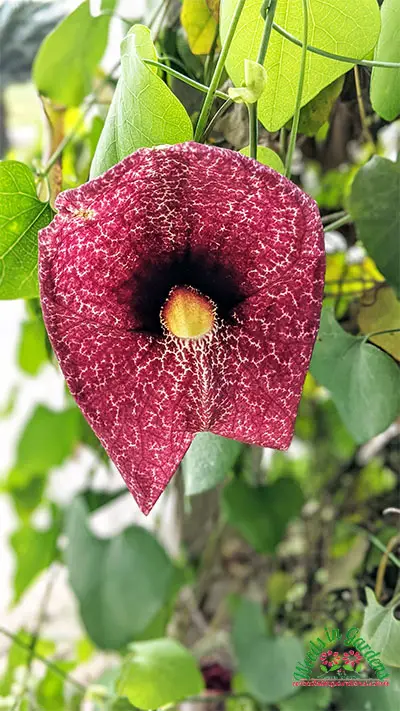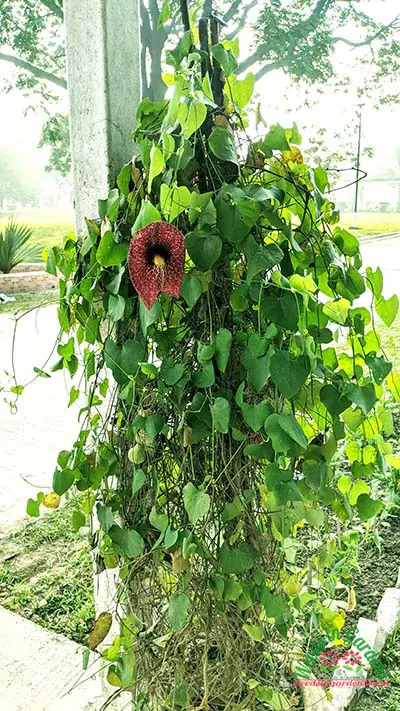
Calico Flower (Scientific name: Aristolochia littoralis) is a beautiful and unique flower species attracting gardeners and nature enthusiasts for centuries. It is also known as the riverbank grape, Dutchman’s pipe or calico bush. This flowering plant is from South America, but it is now grown worldwide, especially in tropical and subtropical areas. The plant is characterized by its long, curved, pipe-like flowers, typically yellow or brown with purple or green markings.
Distribution and range of Calico Flower
Calico Flowers are native to South America and are widely cultivated in many regions of the world, including Asia, Europe, and North America. They prefer warm, humid climates and grow best in full sun or partial shade. In the wild, they are found in a variety of habitats, from tropical forests to coastal areas, and are known for their ability to tolerate a range of soils and growing conditions.
Importance of Calico Flower in gardening and landscaping
Calico Flowers are highly prized for their attractive and unusual flowers, making them popular choices for gardens and landscaping projects. They are often the main focus of a garden design and can be used in everything from simple container gardens to complex landscapes. Calico flowers are also known for attracting pollinators like bees and butterflies, making them an important addition to gardens for both their ornamental value and ecological benefits.
Taxonomy and Botanical Characteristics of Calico Flower
A. Scientific classification of Calico Flower
Kingdom: Plantae
Division: Magnoliophyta
Class: Magnoliopsida
Order: Piperales
Family: Aristolochiaceae
Genus: Aristolochia
Species: Aristolochia Littoralis
B. Physical characteristics and appearance of Calico Flower
Calico Flowers are woody, climbing vines that can grow up to 20 feet in length. They have large, heart-shaped leaves and are known for their distinctive, pipe-shaped flowers, which reach up to 6 inches in length. Most of the time, the flowers are yellow or brown with purple or green spots. They have a unique tubular shape that attracts a wide range of pollinators.
C. Bloom time and life cycle of Calico Flower
Calico Flowers typically bloom from spring to summer and can continue blooming into the early fall in some regions. They have a relatively short life cycle and can grow rapidly, making them a popular choice for gardeners who want quick results. The plant is a fast-growing vine that can be trained to climb trellis or fences, or it can be grown as a trailing ground cover.
Benefits of Calico Flower plant
In addition to its stunning appearance, the calico flower has several other benefits that make it a valuable addition to any garden. For starters, it is a great choice for pollinators like bees, butterflies, and hummingbirds. The nectar-filled flowers give these important insects a good source of food, making them a great addition to any garden that wants to help pollinators.
Another benefit of the Calico Flower is its ability to grow and cover a large area quickly. This makes it ideal for creating privacy screens or covering unsightly garden features. It is also a good choice for erosion control, as its roots can help to stabilize soil and prevent soil loss.
Growing and care guide
A. Soil and climate requirements for Calico Flowers
Calico Flowers are relatively easy to grow and are well-suited for a variety of climates, from tropical regions to temperate zones. They prefer well-drained, organic matter-rich soil and require full sun or partial shade. Also, they can grow in a wide range of soils, including sandy, loamy, and clay soils.
B. Propagation methods for Calico Flowers
Calico Flowers can be propagated by seed or stem cuttings. Seed propagation is typically done in the spring, while stem cuttings can be taken at any time of the year. Stem cuttings are usually the best way to spread a plant because they work faster and are easier to care for than seeds.
C. Watering and irrigation requirements for Calico Flowers
Calico Flowers require regular watering, especially during the growing season. They can handle short periods of drought, but it’s important to keep the soil moist so they can grow and bloom well. Over-watering should be avoided, as this can lead to root rot and other issues.
D. Fertilization requirements for Calico Flowers
Calico Flowers benefit from regular fertilization and can be fertilized with a balanced, water-soluble fertilizer every two to four weeks during the growing season. They can also be fertilized with organic matter, such as compost or aged manure, which helps to improve soil fertility and promote healthy growth.

E. Pruning: Pruning is an important step in keeping Calico Flowers healthy and under control. Prune them regularly to keep them from getting too big and to encourage new growth. You can also use pruning to shape them into a desired form, such as a privacy screen or trellis.
F. Pest Control: Calico Flowers are relatively disease and pest-resistant, but they may still be susceptible to pests like aphids and mites. Keep an eye on infestation signs and use an appropriate insecticide if necessary.
G. Training and Support: Calico Flowers are climbing vines, so they will need support to grow. Use a trellis, arbor, or fence to give them something to climb on. You can also train them to grow in a specific direction or shape.
Designing with Calico Flowers in Landscaping
A. Using Calico Flowers as a focal point
Calico Flowers are a stunning addition to any landscape design, and their distinctive flowers and lush foliage make them an ideal focal point in gardens and landscapes. They can be grown up trellis or fences, or they can be used as trailing ground cover. When grown up a trellis, they can create an attractive wall of green and yellow flowers, making them an excellent choice for privacy screens or garden dividers.
B. Integrating Calico Flowers into mixed borders
Calico Flowers can be used to add color and interest to mixed borders and garden beds. They are well-suited for use as a backdrop for other flowering plants and shrubs, and their large leaves and tubular flowers provide a unique texture and form that sets them apart from other plants. Calico Flowers can create a vibrant yellow and green mass when planted in groups, drawing attention to the surrounding foliage and flowers.
C. Using Calico Flowers in container gardens
Calico Flowers can also be grown in containers, making them a versatile option for patio gardens, balcony gardens, and other small-scale landscaping projects. When grown in containers, they can be trained to climb trellis or fences, or they can be used as trailing ground cover, spilling over the sides of the pot. Container-grown Calico Flowers can also be used to add color and interest to a garden or landscape until more permanent plantings are established.
D. Combining Calico Flowers with other plants
Calico Flowers can be combined with many other plants to create interesting and dynamic garden designs. For example, they can be paired with flowering shrubs and trees, such as roses or magnolias, to create a vibrant and colorful garden scene. They can also be paired with other climbing plants, such as morning glories or clematis, to create a lush, green wall of flowers. When choosing companion plants for Calico Flowers, it is important to consider each plant’s light and water requirements and their growing habits and growth patterns.
Calico Flowers in Traditional Medicine and Folklore
A. Traditional medicinal uses of Calico Flowers
Calico Flowers have a long history of use in traditional medicine, particularly in regions where the plant is native. Roots and leaves of the plant have been utilized to treat a variety of ailments, including stomach problems, skin conditions, and respiratory issues. In traditional medicine, the plant is often used in the form of a decoction, infusion, or poultice.
B. Folklore and cultural significance of Calico Flowers
Calico Flowers have been used in folklore and cultural practices for centuries. For example, in some cultures, the plant is thought to bring good fortune and prosperity, and it is often grown near homes or in gardens for this reason. In other cultures, Calico Flowers are associated with love and passion and are sometimes given as gifts to express affection or desire.
C. Modern research on the medicinal properties of Calico Flowers
In recent years, interest in the medicinal benefits of Calico Flowers has increased., and modern research is beginning to validate many of the traditional uses of the plant. For example, studies have shown that the plant has potent anti-inflammatory and analgesic properties, and It may be effective for treating a range of ailments, including pain, inflammation, and skin irritations. However, additional research is required to comprehend Calico Flower’s therapeutic potential properly, and the use of the plant as a medicine should only be done under the supervision of a licensed healthcare professional.
D. Precautions and side effects of using Calico Flowers
While Calico Flowers have a long history of use in traditional medicine and have been used safely by many people, they can also cause serious side effects, particularly when taken in large doses or when used for extended periods of time. Some most common side effects include nausea, vomiting, dizziness, and stomach cramps. In addition, the plant contains toxic compounds that can creat serious health problems, including kidney damage, respiratory failure, and death. It is important to only use Calico Flowers under the care of a licensed medical professional and to follow all dosage and safety instructions.
Using Calico Flowers in Floral Arrangements and Decor
A. Unique characteristics of Calico Flowers for floral arrangements
Calico Flowers have a number of unique characteristics that make them well-suited for use in floral arrangements and decor. For instance, the trumpet-shaped flowers and pretty leaves of this plant make it a great addition to any arrangement. The plant also blooms for a long time and stays healthy, making it a popular choice for fresh and dried flower arrangements.
B. Incorporating Calico Flowers into floral arrangements
Calico Flowers can be incorporated into a variety of floral arrangements, including bouquets, centerpieces, and wreaths. The plant’s bright, bold flowers are particularly well-suited for tropical-themed arrangements, and they can be paired with other exotic flowers, such as hibiscus, orchids, and bird-of-paradise. Additionally, Calico Flowers can be used to add texture and interest to more subtle, understated arrangements, particularly when dried.
C. Care and handling of Calico Flowers in floral arrangements
When using Calico Flowers in floral arrangements, it is important to handle the plant carefully to ensure its longevity and beauty. For example, the flowers should be cut at the right time and conditioned and hydrated properly. To make sure the plant lives as long as possible, it should also be kept away from extreme temperatures, direct sunlight, and dry air.
D. Creative uses for Calico Flowers in decor
Calico Flowers can be used in a variety of creative ways in decor beyond just traditional floral arrangements. For example, the plant can be used to create beautiful wreaths, garlands, and swags, or it can be used as potpourri when dried or as a natural air freshener. Additionally, Calico Flowers can be used in wedding and event decor, adding a touch of exotic beauty and tropical flair to any celebration.
Calico Flowers in the Wild and Biodiversity
A. Distribution and habitat of Calico Flowers
Calico Flowers are native to a number of regions in South America, and they can be found growing in a variety of habitats, including forests, savannas, and wetlands. The plant does well in tropical and subtropical climates and does best when it is warm and humid.
B. Role of Calico Flowers in ecosystems
Calico Flowers play an essential role in their native ecosystems, serving as a food source and habitat for different wildlife species, including insects, birds, and small mammals. The plant’s nectar and pollen are particularly important to pollinators and provide an important food source for bees, butterflies, and other insects.
C. Threats to Calico Flowers and biodiversity
Unfortunately, a number of things, like deforestation, habitat destruction, and the introduction of invasive species, are threatening Calico Flowers and the places where they live. This loss of habitat is damaging to the Calico Flowers and has a ripple effect on the wider ecosystem, impacting the survival of other plant and animal species.
D. Conservation and protection of Calico Flowers
In order to protect Calico Flowers and their habitats, it is important to take steps to conserve and protect the plant and its natural surroundings. This may involve measures such as planting Calico Flowers in gardens and landscapes, restoring degraded habitats, and controlling the spread of invasive species. By taking action to protect Calico Flowers and their habitats, we can help ensure the survival of this important plant species and the biodiversity of our planet.
Final Thoughts and Future Research Directions
Calico Flowers are a beautiful and versatile plant that have been prized for centuries for their attractive flowers and foliage. The plant is widely cultivated for its use in floral arrangements, landscaping, and traditional medicine, and it is increasingly in demand due to its unique beauty and versatility.
While much is known about Calico Flowers, there is still much to learn about this important and fascinating plant. For example, further research is needed to understand the plant’s genetics, growth patterns, and response to different environmental conditions. More research is also needed to find out how the plant’s traditional medicinal properties can be used to improve human health and wellness.
Calico Flowers are a plant with a rich history and a bright future. As demand for the plant continues to grow, hopefully, we will see continued advances in our understanding and use of Calico Flowers in the future. Calico Flowers will captivate and inspire you whether you are a gardener, a florist, or just someone who enjoys the beauty of nature.
In conclusion, the Calico Flower (Aristolochia littoralis) is a beautiful, unique, and useful addition to any garden. Its striking appearance, benefits for pollinators, quick growth, and low-maintenance requirements make it a great choice for gardeners. Calico Flowers significantly impacts various fields, such as horticulture, traditional medicine, and the global market. Growing calico flowers can be a rewarding experience for gardeners of all levels. With the right location, planting, watering, pruning, fertilizing, pest control, training, and help, you can grow these beautiful and unique flowers in your garden. Whether you’re looking to add a little color and beauty to your yard or support pollinators and create a privacy screen, the calico flower is a great choice.
So go ahead and experiment with this lovely flowering plant, and enjoy the beauty of Calico Flowers in your own backyard!
